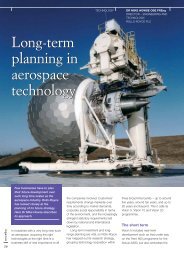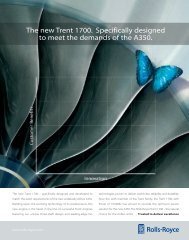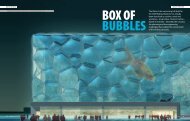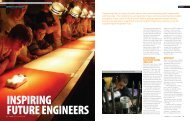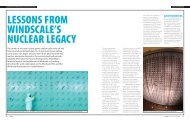Gas turbine technology - Ingenia
Gas turbine technology - Ingenia
Gas turbine technology - Ingenia
You also want an ePaper? Increase the reach of your titles
YUMPU automatically turns print PDFs into web optimized ePapers that Google loves.
PHILIP RUFFLES CBE FREng FRS<br />
DIRECTOR, ENGINEERING AND<br />
TECHNOLOGY, ROLLS-ROYCE PLC<br />
EARTH, AIR AND WATER<br />
<strong>Gas</strong> <strong>turbine</strong> <strong>technology</strong><br />
Powering the future<br />
Trent 700 engines power these Dragonair<br />
A330 aircraft at Hong Kong airport.<br />
Introduction<br />
The engines that power modern jet<br />
aircraft are incredibly powerful and<br />
robust, making use of the most<br />
advanced materials and design<br />
features. Phil Ruffles describes the<br />
craft of the jet-engine manufacturer<br />
and discusses some of the technical,<br />
environmental and economic issues<br />
that shape the engines of today and<br />
tomorrow.<br />
Air travel is the fastest growing mode of<br />
transportation in the world today.<br />
According to the International Civil<br />
Aviation Organisation (ICAO), some<br />
1560 million passengers and 28 million<br />
tonnes of freight were transported by<br />
air in 1999 and forecasts indicate that<br />
this trend is set to continue. A 20-year<br />
market forecast conducted by Rolls-<br />
Royce last year predicts that economic<br />
growth, averaging 3% each year, will be<br />
outstripped by the growth in passenger<br />
traffic at 5% and cargo traffic at 6.5%.<br />
This picture presents exciting<br />
opportunities for the aviation industry.<br />
But against this backdrop, a number<br />
of issues emerge. As established<br />
airlines and a rapidly escalating number<br />
of new start-up carriers vie for<br />
customers, competition in the industry<br />
is fierce. Airlines operating with reduced<br />
margins year on year demand<br />
increasingly efficient products to reduce<br />
their operating costs. Reliability is also<br />
ingenia<br />
13
EARTH, AIR AND WATER<br />
imperative. The continual drive to<br />
maximise fleet utilisation while<br />
minimising unscheduled delays is a<br />
feature of modern civil aviation that is<br />
likely to intensify. Aircraft turnaround<br />
times, currently as tight as 20 minutes,<br />
will be further reduced, demanding<br />
robust products that excel in<br />
demanding conditions.<br />
As an inevitable result of the<br />
explosion in civil travel, our skies – and<br />
our airports – are becoming increasingly<br />
congested. This is a reality affecting<br />
governments, town planners and global<br />
air traffic management systems, and<br />
one that requires radical reappraisal<br />
from the aviation industry on the future<br />
of civil transport. Should aircraft makers<br />
focus on bigger jets to carry more<br />
people or faster aircraft with more<br />
range, to get people to their<br />
destinations without stopping off and in<br />
less time than it takes current subsonic<br />
aircraft?<br />
A further development resulting from<br />
the growth in air travel is the hot debate<br />
surrounding emissions. These are an<br />
unavoidable by-product of burnt fossil<br />
fuels and are the target of increasingly<br />
stringent global environmental<br />
legislation. So aircraft makers and<br />
associated suppliers must develop<br />
products that continue to mitigate their<br />
impact on our atmosphere.<br />
For aero engine makers the<br />
challenge is to design, manufacture and<br />
bring to market products that are<br />
increasingly reliable, efficient, kind to the<br />
environment and affordable, all of which<br />
present their own unique engineering<br />
challenges. The research and<br />
development spends necessary to<br />
achieve these goals in the specialised<br />
aero engine industry are considerable.<br />
Thus Rolls-Royce has developed<br />
engine technologies which have the<br />
inherent design capability to transfer<br />
across to new engine variants and be<br />
retrofitted on existing ones.<br />
applied builds on the established<br />
principles of the gas <strong>turbine</strong> engine,<br />
commonly known as the ‘jet’ engine.<br />
Since the advent of gas <strong>turbine</strong><br />
<strong>technology</strong> in the 1930s, the total<br />
power output that can be achieved has<br />
increased by a factor of 50 while fuel<br />
requirements (specific fuel<br />
consumption) have been cut by 75%.<br />
These milestones have been driven by<br />
the development of advanced<br />
<strong>technology</strong> in many areas, amongst<br />
them thermodynamics, aerodynamics<br />
and materials science.<br />
Like the motor car engine, the gas<br />
<strong>turbine</strong> is an internal combustion<br />
engine. In both, air is compressed, fuel<br />
added, the mixture ignited and the<br />
rapid expansion of the resultant hot gas<br />
produces the power. Unlike the motor<br />
car engine, however, where power is<br />
intermittent and the expanding gas<br />
produces shaft power through a<br />
mechanical piston and crank, in a jet<br />
engine combustion is continuous and<br />
its power results from expanding gas<br />
being forced out of the rear of the<br />
engine. The jet engine relies on<br />
Newton’s Third Law where every action<br />
has an equal and opposite reaction.<br />
The expanding gas flow is an action<br />
which creates a reaction of equivalent<br />
force, referred to as thrust. Thrust is<br />
transmitted through the engine to the<br />
aircraft, propelling it through the air.<br />
The first gas <strong>turbine</strong> engines to fly in<br />
service were turbojets, used in a variety<br />
of military applications. Relying on highvelocity<br />
hot gas passing entirely through<br />
the compressor, combustor and<br />
<strong>turbine</strong>s to provide thrust, this engine is<br />
designed primarily for speed, but<br />
carries the penalties of relatively high<br />
fuel consumption and noise levels.<br />
The turbo prop, as its name<br />
suggests, uses a propeller to transmit<br />
the power it produces into thrust. The<br />
propeller is driven by a shaft from a<br />
power <strong>turbine</strong>, utilising the gas energy<br />
which would provide the thrust directly<br />
in a turbo jet. Similarly, the turbo shaft<br />
powerplant for helicopters uses a<br />
power <strong>turbine</strong>, but in this instance the<br />
power is transmitted to the rotor<br />
system of the helicopter. This type of<br />
engine is also used in industrial and<br />
marine applications, where it can drive<br />
electrical generators, pumps or a<br />
variety of marine propulsors.<br />
Today, modern, large civil transport<br />
aircraft are powered by turbo fan<br />
engines. In these ‘bypass’ gas <strong>turbine</strong>s<br />
a large mass of air is pressurised by a<br />
big fan at the front of the engine – at<br />
take off a Trent 800 powering a Boeing<br />
777 would empty all the air in a squash<br />
court in a third of a second. Some of<br />
this air then passes through the engine<br />
core, where it is further pressurised<br />
before the combustion and expansion<br />
processes. The remaining fan air flows<br />
through the bypass duct, re-mixes with<br />
the hotter core gas and leaves through<br />
the nozzles as the jet which provides<br />
the engine’s thrust.<br />
The bypass ratio – the mass of air<br />
going down the bypass stream divided<br />
by the mass going through the core – is<br />
the principal difference between<br />
modern civil and military aero engines.<br />
For example, the EJ200 engine built for<br />
the Eurofighter has a bypass ratio of<br />
ingenia<br />
14<br />
The jet engine<br />
The basis on which most short- to<br />
medium-term research is focused and<br />
Figure 1: The jet engine.
EARTH, AIR AND WATER<br />
Figure 2: The Rolls-Royce Trent 800.<br />
0.4 whereas on large modern civil<br />
engines it can be as high as 9, with the<br />
fan air producing more than 80% of the<br />
total thrust. Higher bypass ratios are<br />
used on civil transports for their<br />
improved fuel consumption and lower<br />
noise levels, whereas lower bypass<br />
ratios are used on military applications<br />
for their higher thrust-to-weight ratio.<br />
The new generation<br />
With an eye on the forecast market<br />
growth in large civil transport aircraft<br />
carrying upwards of 300 passengers,<br />
Rolls-Royce embarked on a new<br />
engine strategy in the early 1990s to<br />
design and manufacture a high-bypass<br />
turbo fan engine which could be<br />
optimised for a range of large widebody<br />
civil aircraft.<br />
Consuming over a billion<br />
pounds in research and<br />
development costs and<br />
12,000 man years of<br />
engineering effort, the<br />
unique Trent three-shaft<br />
engine architecture is<br />
derived from the earlier<br />
Rolls-Royce RB211 engine<br />
series and features a<br />
number of innovations.<br />
Low, intermediate and<br />
high pressure systems, each consisting<br />
of a number of compressor and <strong>turbine</strong><br />
stages, are mounted on independent<br />
shafts which run at their optimum<br />
aerodynamic speeds. As a guide, for a<br />
Trent 800 engine, the low pressure<br />
system will operate at 3000 revolutions<br />
per minute (rpm), the intermediate<br />
pressure system at 7500 rpm and the<br />
high pressure system at 10,000 rpm.<br />
The fan needs to rotate relatively slowly,<br />
being limited by the stress and<br />
aerodynamic tip speed of the blade.<br />
Optimum engine efficiency, governed<br />
by the maximum pressure and<br />
temperature achieved in its core, is<br />
enhanced by the three-shaft design.<br />
The pressure of the air as it enters the<br />
combustion and <strong>turbine</strong> components<br />
in a Trent engine is at around 40<br />
atmospheres, with <strong>turbine</strong> entry<br />
temperatures above 1600°C providing<br />
an environment significantly in excess of<br />
the components’ melting temperatures.<br />
This necessitates advanced materials,<br />
including ceramic coatings, and cooling<br />
technologies.<br />
A further benefit of the three-shaft<br />
concept is the ease with which it can<br />
be optimised for specific aircraft<br />
applications. The Trent family provides a<br />
thrust range from 53,000 lb to more<br />
than 100,000 lb by scaling its<br />
modularised components: the fan,<br />
compressor, combustor and <strong>turbine</strong><br />
systems. In addition to the applications<br />
shown in the figure, a Trent 8104<br />
engine has run to 104,000 lb and<br />
demonstrated <strong>technology</strong> for future<br />
projects.<br />
The ‘family’ concept is attractive on<br />
a number of counts, particularly in<br />
engine development, which is cost<br />
effective and ensures that customers<br />
obtain the benefit associated with a<br />
completely new and different product<br />
without Rolls-Royce incurring excessive<br />
risk. Maintenance costs, including<br />
training and tooling, are also reduced<br />
due to the high level of commonality<br />
between different versions of the Trent.<br />
Finally, new technologies, proven in<br />
service, can be retrofitted to existing<br />
variants. For instance, Trent <strong>technology</strong><br />
has been incorporated in the RB211-<br />
524G/H-T engine, providing increasing<br />
competitiveness on the Boeing 747<br />
and 767.<br />
Figure 3: The Rolls-Royce Trent family.<br />
Trent <strong>technology</strong>:<br />
the wide-chord fan blade<br />
The wide-chord fan blade (WCFB),<br />
pioneered by Rolls-Royce in the 1980s<br />
on the RB211-535 engine for the Boeing<br />
B757, is an example of successfully<br />
applied <strong>technology</strong>. Designed specifically<br />
for high-bypass turbo fans, the latest<br />
standard of WCFB is made from three<br />
layers of titanium which are first formed,<br />
then bonded together using the<br />
diffusion-bonded superplastically formed<br />
(DB-SPF) process, and then inflated to<br />
produce an exceptionally strong, hollow<br />
and lightweight structure. While each fan<br />
ingenia<br />
15
EARTH, AIR AND WATER<br />
ingenia<br />
16<br />
blade exerts a centrifugal force of around<br />
70 tonnes, equivalent to the weight of a<br />
modern locomotive, the resulting fan set<br />
is far lighter than those in competing<br />
powerplants, contributing significantly to<br />
the Trent’s overall weight advantage.<br />
Figure 4: The wide-chord fan blade.<br />
This innovation was first introduced on<br />
the Trent 700 for the Airbus Industrie<br />
A330 in 1995. It has since been<br />
optimised for all derivative Rolls-Royce<br />
Trent engines either in service (with the<br />
Trent 800 on Boeing’s current 777) or in<br />
development. The Trent 500 for Airbus<br />
Industrie’s A340-500/600, scheduled to<br />
enter service next year, features the<br />
WCFB; an advanced ‘swept’ version is<br />
being designed for the Trent 900 under<br />
development for the European<br />
manufacturer’s super-large A380 aircraft<br />
programme.<br />
Trent <strong>technology</strong>: the highpressure<br />
<strong>turbine</strong> blade<br />
<strong>Gas</strong> <strong>turbine</strong> aero engines are<br />
assembled from components made to<br />
specifications matched by few other<br />
industries in their exacting<br />
requirements. Advanced materials<br />
research plays a key role in the design<br />
process, in particular for highperformance<br />
parts which require<br />
resilience to extreme environments. An<br />
end product of this discipline is the<br />
High-Pressure Turbine (HPT) blade. The<br />
function of HPT blades (92 of which are<br />
employed in a Trent 800 engine) is to<br />
extract power from the hot gas stream<br />
exiting the engine’s combustion<br />
chamber, in order to drive the six stage<br />
High-Pressure Compressor (HPC).<br />
First, the blades must be immensely<br />
strong and robust. Each HPT blade<br />
operates at a speed of 10,000 rpm and<br />
extracts around 750 horse power –<br />
about the same as a Formula 1 racing<br />
car. The blades will average a minimum<br />
of 15,000 hours in service between<br />
engine overhauls. An aircraft will have<br />
flown approximately eight million miles<br />
during this period. As HPT blades do<br />
their work in the hottest part of the<br />
engine core, they must also be able to<br />
function at peak performance in gas<br />
temperatures of up to 1600°C.<br />
Comprising an advanced nickel alloy<br />
base with additions of cobalt, chromium,<br />
tantalum, tungsten, aluminium, rhenium<br />
and other trace elements, additional<br />
strength is derived by the specially<br />
controlled casting process which<br />
removes the normal formation of<br />
solidifying grains in the metal. These<br />
grains, with boundaries between them,<br />
are potential sites for impurities and<br />
weakness. Control of the solidification<br />
process allows the blade to be cast as<br />
one single crystal of nickel alloy with no<br />
grain boundaries. The resulting blade has<br />
a temperature melting point of between<br />
Figure 5: Cutaway of an HPT blade.<br />
1200°C and 1300°C and operates at an<br />
average metal temperature of 1000°C.<br />
Its hollow design allows air to flow<br />
through internal passages to cool the<br />
component, before passing through<br />
holes to form a protective film over the<br />
blade surface. ‘Cool’ air temperatures<br />
are, in the case of a large civil turbo fan<br />
engine, in the region of 650°C.<br />
Reducing environmental<br />
impact<br />
The continual reduction of emissions<br />
and noise continues to be at the<br />
forefront of advanced aero engine<br />
design. But designing an engine which<br />
achieves both optimum performance<br />
and low emissions presents a<br />
conundrum at the epicentre of<br />
advanced aero engineering.<br />
Increased temperatures improve the<br />
thermodynamic cycle and the engine<br />
fuel efficiency; indeed, since the 1960s<br />
the fuel burnt per passenger seat has<br />
more than halved due to improved<br />
engine <strong>technology</strong> and lighter aircraft<br />
designs. This has a direct benefit in<br />
reducing the amount of CO 2<br />
produced.<br />
However, nitrogen and oxygen – both<br />
present in the atmosphere – react at<br />
very high temperatures and this<br />
chemical reaction produces nitrogen<br />
oxides, NOx, a contributor to acid rain.<br />
The higher the air temperature and<br />
exposure time to these high<br />
temperatures, the greater the<br />
production of NOx.<br />
Advanced combustion <strong>technology</strong><br />
has come a long way in addressing<br />
these issues. Today by-products such<br />
as soot, smoke, hydrocarbons and<br />
carbon monoxides have all but<br />
disappeared. Emissions of nitrogen<br />
oxides have been reduced by making<br />
improvements to combustor mixing<br />
processes by lowering peak gas<br />
temperatures and reducing burning<br />
exposure time in the ‘hot spots’ of the<br />
combustion chamber.<br />
Great strides have been made by<br />
the aviation industry during the last 30<br />
years in reducing noise pollution. About<br />
20 decibels (a fourfold reduction) has
EARTH, AIR AND WATER<br />
been cut from aircraft noise in this time<br />
through the use of improved<br />
<strong>technology</strong>. However, as numbers of<br />
aircraft multiply, increasing regulatory<br />
attention is being focused on the issue<br />
of noise emissions both on take-off and<br />
landing.<br />
An example of how <strong>technology</strong> is<br />
being used to reduce noise is the swept<br />
fan, which has potential to further<br />
reduce an aircraft’s total noise<br />
emissions. Progress in a number of<br />
other areas is being made. Working<br />
closely with engine nacelle<br />
manufacturers, Rolls-Royce is<br />
conducting research to extend an<br />
engine’s lower-lip intake, referred to as<br />
‘negative scarfing’, to re-direct engine<br />
noise normally affecting airport<br />
communities ‘into the skies’. Treatments<br />
to muffle noise generated by engine<br />
core components, including advanced<br />
acoustic liners, are also being evaluated.<br />
Future concepts<br />
Incremental changes to gas <strong>turbine</strong><br />
<strong>technology</strong> have yielded improvements<br />
in performance and reliability since the<br />
advent of the gas <strong>turbine</strong>. Alongside<br />
improvements in traditional areas, the<br />
search for continuous reductions in<br />
cost and environmental emissions may<br />
require a departure from the boundaries<br />
of existing gas <strong>turbine</strong> architecture.<br />
Amongst the concepts being studied<br />
by the industry which may make their<br />
way on to the world’s runways in a few<br />
years time, Rolls-Royce engineers are<br />
investigating the concept of the ‘More<br />
Electric Engine’.<br />
This engine is based on a revised<br />
Trent engine architecture with fewer<br />
compressor and <strong>turbine</strong> stages;<br />
benefits are largely derived from the<br />
elimination of the aircraft pneumatic<br />
system, together with significant<br />
simplifications in the aircraft–engine<br />
interface. Power will be produced by<br />
generators embedded in the engine<br />
and, ultimately, it may be possible to<br />
remove the engine oil system<br />
completely. Many studies have shown<br />
that the integration of the More Electric<br />
Engine into the More Electric Aircraft<br />
would result in worthwhile cost and<br />
efficiency savings. While the concept is<br />
still in its infancy, some aspects of this<br />
<strong>technology</strong> could enter service within<br />
the next ten years.<br />
Some passengers are prepared to<br />
pay premium fares and this group is<br />
likely to welcome the contribution to<br />
reduced journey times of flying faster.<br />
The need for large aeroplanes with<br />
significantly increased speed seems<br />
unlikely in the near to medium term.<br />
However, the engine maker must now<br />
give consideration to the availability<br />
within current horizons of a small-tomedium<br />
aircraft operating at near sonic<br />
speeds.<br />
<strong>Gas</strong> <strong>turbine</strong> <strong>technology</strong>, such as that<br />
which has made the Trent family so<br />
successful, is directly applicable to a<br />
powerplant for a 250 to 300 seat<br />
aircraft flying at around sonic speeds.<br />
Studies suggest that the engine cycle<br />
selected for such an application would<br />
differ from that which would be chosen<br />
for a similarly sized conventional<br />
subsonic aircraft. A greater proportion<br />
of the energy would have to be<br />
provided by the core in order to satisfy<br />
climb and cruise considerations. This<br />
emphasises the need for lightweight<br />
materials and high-temperature<br />
capability in the compressor and<br />
<strong>turbine</strong>, and provides demanding<br />
requirements in terms of noise and<br />
emissions.<br />
In years to come, whether airframe<br />
makers and customers demand step<br />
changes in gas <strong>turbine</strong> <strong>technology</strong> or<br />
leaps into new directions, it is likely that<br />
developments will be driven by a<br />
combination of economic and<br />
environmental conditions and technical<br />
feasibility. Whatever the future brings,<br />
the drive to provide value through<br />
innovative engineering solutions<br />
remains as strong as ever. ■<br />
Figure 6: The more electric engine.<br />
Philip Ruffles joined Rolls-Royce in<br />
1961 and has held<br />
a variety of senior<br />
engineering<br />
positions. He was<br />
appointed to the<br />
Main Board<br />
as Director,<br />
Engineering and Technology, in<br />
January 1997. He has received many<br />
awards and distinctions including the<br />
Royal Academy of Engineering<br />
MacRobert Award for his work on<br />
the Trent engine and the Institute of<br />
Mechanical Engineers James<br />
Clayton Prize for his contribution to<br />
aero engine <strong>technology</strong>.<br />
Email: phil.ruffles@rolls-royce.com<br />
ingenia<br />
17


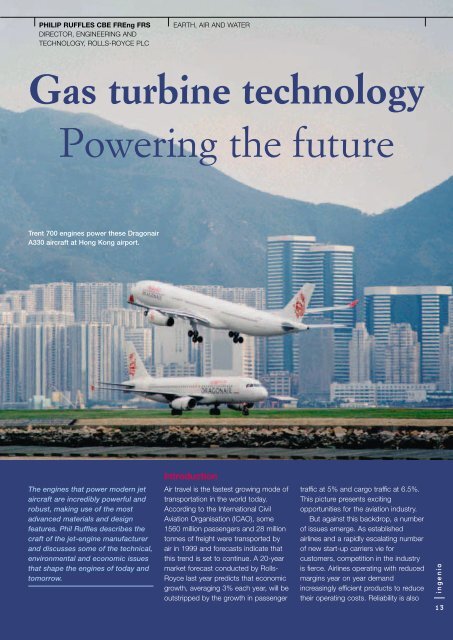


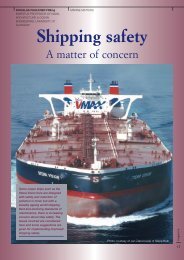

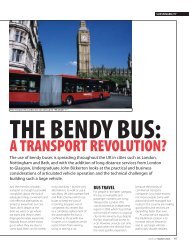
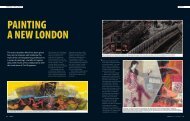
![[322/03] Francke - Ingenia](https://img.yumpu.com/23411337/1/184x260/322-03-francke-ingenia.jpg?quality=85)

